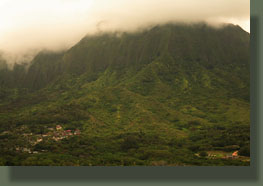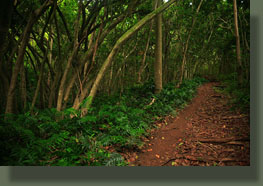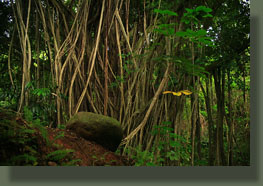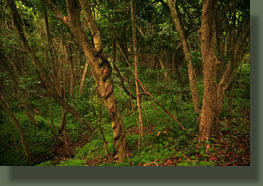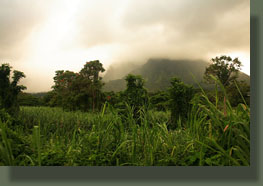| Location:
windward side of Oahu, near Kailua
Maps: 1:24K USGS quad: Koko Head Access: The TH lies about ½ mile past the security shack for the Luana Hills Country Club. You can park just off the Kalaniana’ole Highway and walk in. Trail: Very difficult (especially when wet), 5-mile round trip to the first of three peaks Fees: None I searched online for an Oahu hiking guide when I first planned to visit Dave on Oahu in 2004. I found and purchased a used copy of Stuart Ball’s Hiker’s Guide to Oahu. On the cover of the revised edition, there is a photo of two hikers standing on top of a plunging cliff face, with a knife-edged peak nearby. The image is of the second and third peaks of Olomana, a spectacular group of three sharp peaks jutting up from the flat plain east of the Ko’olau Range. I was pretty taken with this photo, and it got my blood up to go hiking on Oahu. That first trip in 2004, I never made it to Olomana, nor did I really want to, given the author’s warnings of peril. During my second trip to visit Dave in 2007, shortly before his wedding, we discussed Olomana, and although he had never hiked it, he warned me that he had heard from friends that it was difficult and more than just a little dangerous. I once again shelved the idea, and went about my week hiking very tame trails in the jungles of the Ko’Olau Range. At the rehearsal for Dave’s wedding, I noted that the location of the ceremony was at the foot of Olomana in the Luanna Hills Country Club. At Dave’s wedding, a friend of his named Sean sat next to me at dinner and while we talked of hiking locations on the island, he suggested I attempt Olomana. I pointed out that all sources rated it as highly dangerous. He concurred it was dangerous, but that if one were careful, it was a perfectly reasonable hike. He furthermore described to me his multiple summits of Olomana, and his descriptions did not sound too terrible. So, two days after the wedding, on my final day in Hawaii, after a short morning hike along Makua Ridge in the northeastern part of Oahu, I decided to give Olomana a shot. If it got too scary, I could always simply turn around. The trailhead is on private property,
so you have to park outside the front entrance to the Luanna Hills Country
Club and walk in past the guardshack. Since I had been to the Country Club
twice already, I knew how to get there, although I didn’t know exactly
where I should park until I saw the line of 4 cars along the side of the
road near Maunawilli Creek. It was shortly after noon when I finally got
my stuff together in my pack and headed up the road. Although I had been
rained on while hiking that morning, the sky was clear when I started off,
and it was consequently pretty hot. I followed the road past the guard
shack, said hello to the guard, and kept going another ½ mile to
the trailhead which is right along the south side of the road and clearly
marked with a sign. I stepped off the road, and with 4 steps left the world
of manicured roadside grass and pavement and entered full on jungle. Strawberry
guava trees and glossy green laua’e ferns lined the trail, which ran at
a moderate incline to an old shack that was almost overtaken by a nearby
massive banyan tree. The trail turned left at the shack, and the grade
got steeper. As my flight was leaving that evening, I felt compelled to
hurry up a little so as to give myself a decent shot at completing the
hike in the afternoon, and having enough time left over to shower at a
beach park, have dinner and get to the airport on time. Thus, I moved along
at a pretty good clip, and I was soon dripping sweat from my nose. I periodically
swiped my face with a red handkerchief that I held in my left hand. Although
I was breathing heavy, I had lots of energy that day, and I kept going
without pause as the trail passed through a dense stand of ironwood, then
up a ridgeline that afforded periodic views of the surrounding land. It
was apparent that the trail would lead to great views in a very short time.
Large wooden posts sat next to the trail at intervals of a few hundred
yards, the function of which I never learned. A group of three people passed
me on their way down, and we exchanged friendly greetings in passing. Meanwhile
the trail continued relentlessly uphill, never going downhill. In a way
this is great, since the purpose of the trail is to get you to the top
and any downhill stretches on a summit trail are counterproductive as far
as the destination goes. The grade got steeper and steeper, and soon I
was using my hands to grip short tree trunks to pull myself along the rocky
grade. Through the thin screen of vegetation, I could see the ocean to
my left, and the mossy green face of the Ko’Olau Range my right. At a couple
of points, fixed ropes aided the ascent, and I was grateful they were there.
At the top of the second set of fixed ropes, I stopped for the first time
and rested. I couldn’t see the top of Olomana through the vegetation, but
I sensed I was getting fairly close. Continuing on, I slowed my pace out
of necessity as the trail became much more difficult, mainly due to the
steepness of it. If not for the sturdy trees on either side of the trail
to hold onto, I would probably have turned back before I reached the 12-foot
near-vertical rock face near the summit. A thick rope hung from the top,
and there is really nothing to do but pull yourself up when you get here.
The trees run out, so it is a fairly unnerving maneuver. I managed to get
to the top in a few pulls, but when I got to the top, I found that there
is really nothing to grab onto to pull yourself up except smooth rock.
I clawed for a good fingerhold and tried to pull myself up, only to be
held back by my pack, which had caught on the rock on my right side. Unable
to go back down, I simply pulled very hard, and shot forward onto the smooth
rock. At the same time, I heard a series of clunks, and I looked over my
shoulder to see my water bottle, which had been in the mesh side pocket
of my pack, bounce down the rock face and out of sight down the thickly-vegetated
slope. I turned my head and looked up the trail to see two guys sitting
10 feet away, watching me.
Near the very top, I reached two
more people on their way down.
|
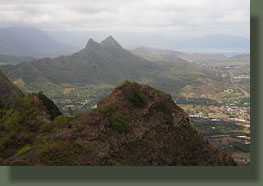
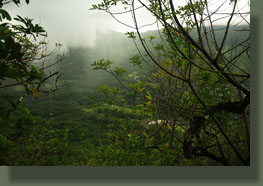
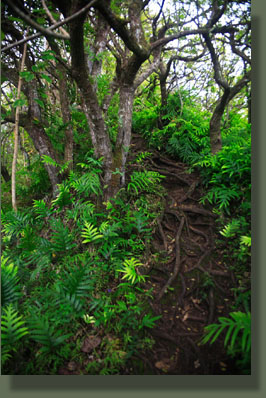
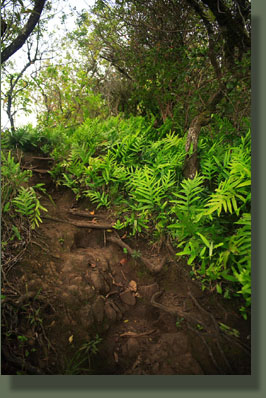
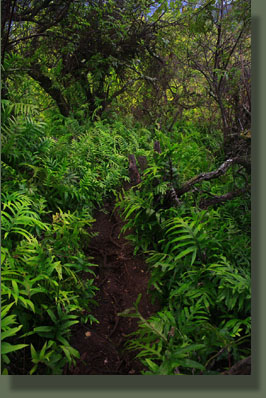
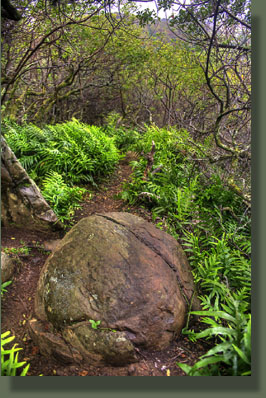
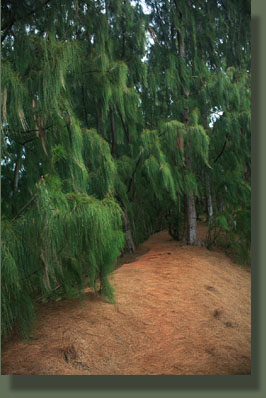
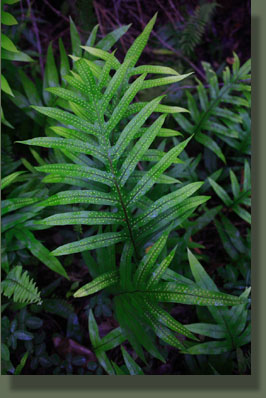
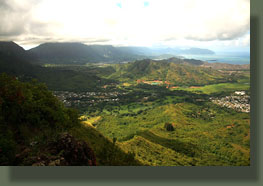
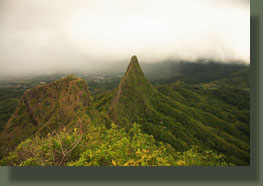

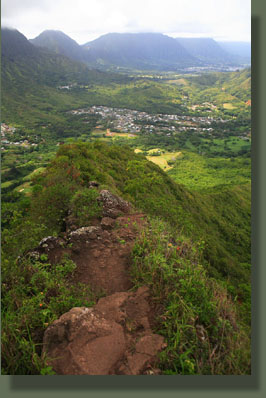
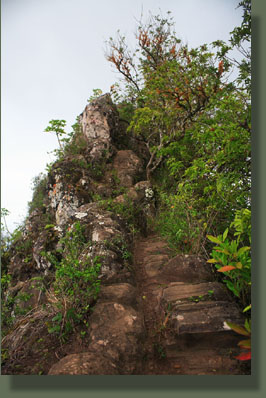
 |
